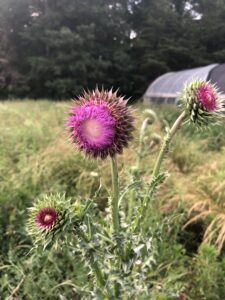3/14/2021 Although we are constantly surrounded by plants, they are living things that are easily overlooked since they don’t move, they simply exist, and they are abundant. I am extremely interested in botany so I pride myself as someone who notices the plants most people ignore. I take walks on my farm, the trails breaching the borders of several different kinds of environments, from wetlands and streams, to forested areas, to pastures, and stop at every new plant, snap a picture and then identify it once I get back to the house. I have since learned a large collection of different plants and fungi, from beautiful showy flowers and bushes, to more subtle but still fascinating plants all of which reside on my farm in Southern Virginia.
During the fall I took a lot of walks and I quickly noticed a few plants that stood out. Strawberry bush was one I had never seen before. It immediately caught my attention since the fruiting bodies are bright fuschia with hanging orange seeds that are just as beautiful as a flower and don’t resemble anything I can think of, they are just strange structures. The Strawberry bush I found was spindly without leaves and around 6 ft tall. The fruiting bodies almost resemble christmas ornaments.
Throughout the summer there were, of course, the showy flowers like Black Eyed Susans, Queen Anne’s Lace, Goldenrod, and Milkweed, but one day when walking in the forest, the heat suffocating, I noticed a funky looking flower that resembles those carnivorous flowers you think only appear in tropical rainforests\. It was Jack in the Pulpit, a pitcher shaped flower that attracts flies for pollination and sports bright red berries tucked away on the forest floor, hidden away by its three large leaves. I would have missed it if not for the deep dark purple stripes going from the top to the bottom of the flower.
There are also tons of medicinal plants on my farm, such as Mountain Mint which can be good for menstrual cycle regulation, a plant that has the distinct menthol smell and taste of every mint plant, and it prefers to grow along the edge of our forests. I can spot it from far away as the leaves are sometimes covered in a silvery powder and have delicate purple flowers that bees love. Another plant with silvery leaves is Jewelweed, a very well known “cure” for poison ivy. It’s much more delicate than the sturdy mountain mint, and prefers moist environments right next to streams. In the spring, delicate spotted orange flowers bloom that attract butterflies. The cool thing about Jewelweed, is that if you try to dunk it in water, there is a coating on each leaf that repels water like a solid silvery force field. It also has spring loaded seeds that shoot at you if you brush up against them like miniature cannons.
Lastly we have invasive plants. The plants that takeover with very little control, plants like Thistle or Johnson grass, the bane of my Mom’s existence, that have large seed heads and deep tap roots making it impossible to kill and stay killed, because if you leave even one tiny piece of tap root you are going to see it again in a few months. The tap roots can go a foot or more in the ground and usually break off if you try to pull them. The grass towers above your head, and yes, it is beautiful, with the purple tint and sturdy stem and the beautiful sound it makes when it sways in the wind, or thistle which creates a beautiful pink flower, although not conventionally beautiful, and painful to touch because of the thorns, it is not worth keeping, because once you have it, it won’t go away. Sometimes I wish I was as persistent as Johnson grass.

Glaettli, Repp. Piedmont Native Plants: a Guide for Landscapes and Gardens. Piedmont Natives, 2013. https://static1.squarespace.com/static/58e25c41e6f2e17ea4cb7766/t/5c7e9fdceef1a1aa5076c56b/1551802341422/Piedmont+Native+Plant+Guide+-+April+2016.pdf
Mahr, Susan, Written by. “Jewelweed, Impatiens Capensis.” Wisconsin Horticulture, hort.extension.wisc.edu/articles/jewelweed-impatiens-capensis/.
TWC, Staff. “Euonymus Americanus.” Lady Bird Johnson Wildflower Center – The University of Texas at Austin, 2018, www.wildflower.org/plants/result.php?id_plant=euam9.
TWC, Staff. “Arisaema Triphyllum.” Lady Bird Johnson Wildflower Center – The University of Texas at Austin, 2013, www.wildflower.org/plants/result.php?id_plant=artr.